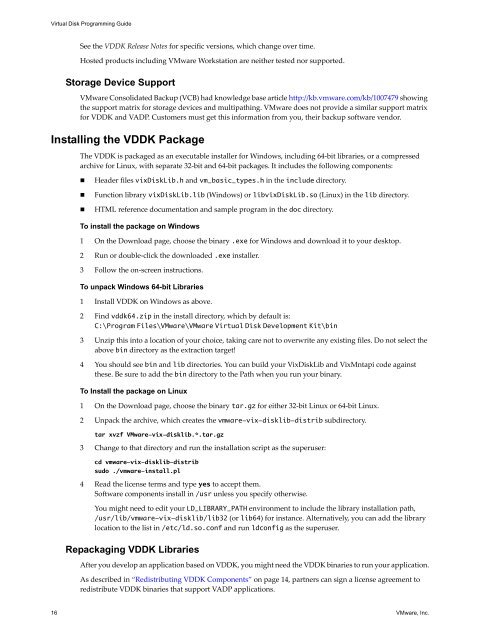Virtual Disk API Programming Guide - Documentation - VMware
Virtual Disk API Programming Guide - Documentation - VMware
Virtual Disk API Programming Guide - Documentation - VMware
You also want an ePaper? Increase the reach of your titles
YUMPU automatically turns print PDFs into web optimized ePapers that Google loves.
<strong>Virtual</strong> <strong>Disk</strong> <strong>Programming</strong> <strong>Guide</strong><br />
See the VDDK Release Notes for specific versions, which change over time.<br />
Hosted products including <strong>VMware</strong> Workstation are neither tested nor supported.<br />
Storage Device Support<br />
<strong>VMware</strong> Consolidated Backup (VCB) had knowledge base article http://kb.vmware.com/kb/1007479 showing<br />
the support matrix for storage devices and multipathing. <strong>VMware</strong> does not provide a similar support matrix<br />
for VDDK and VADP. Customers must get this information from you, their backup software vendor.<br />
Installing the VDDK Package<br />
The VDDK is packaged as an executable installer for Windows, including 64‐bit libraries, or a compressed<br />
archive for Linux, with separate 32‐bit and 64‐bit packages. It includes the following components:<br />
Header files vix<strong>Disk</strong>Lib.h and vm_basic_types.h in the include directory.<br />
Function library vix<strong>Disk</strong>Lib.lib (Windows) or libvix<strong>Disk</strong>Lib.so (Linux) in the lib directory.<br />
HTML reference documentation and sample program in the doc directory.<br />
To install the package on Windows<br />
1 On the Download page, choose the binary .exe for Windows and download it to your desktop.<br />
2 Run or double‐click the downloaded .exe installer.<br />
3 Follow the on‐screen instructions.<br />
To unpack Windows 64-bit Libraries<br />
1 Install VDDK on Windows as above.<br />
2 Find vddk64.zip in the install directory, which by default is:<br />
C:\Program Files\<strong>VMware</strong>\<strong>VMware</strong> <strong>Virtual</strong> <strong>Disk</strong> Development Kit\bin<br />
3 Unzip this into a location of your choice, taking care not to overwrite any existing files. Do not select the<br />
above bin directory as the extraction target!<br />
4 You should see bin and lib directories. You can build your Vix<strong>Disk</strong>Lib and VixMntapi code against<br />
these. Be sure to add the bin directory to the Path when you run your binary.<br />
To Install the package on Linux<br />
1 On the Download page, choose the binary tar.gz for either 32‐bit Linux or 64‐bit Linux.<br />
2 Unpack the archive, which creates the vmware-vix-disklib-distrib subdirectory.<br />
tar xvzf <strong>VMware</strong>-vix-disklib.*.tar.gz<br />
3 Change to that directory and run the installation script as the superuser:<br />
cd vmware-vix-disklib-distrib<br />
sudo ./vmware-install.pl<br />
4 Read the license terms and type yes to accept them.<br />
Software components install in /usr unless you specify otherwise.<br />
You might need to edit your LD_LIBRARY_PATH environment to include the library installation path,<br />
/usr/lib/vmware-vix-disklib/lib32 (or lib64) for instance. Alternatively, you can add the library<br />
location to the list in /etc/ld.so.conf and run ldconfig as the superuser.<br />
Repackaging VDDK Libraries<br />
After you develop an application based on VDDK, you might need the VDDK binaries to run your application.<br />
As described in “Redistributing VDDK Components” on page 14, partners can sign a license agreement to<br />
redistribute VDDK binaries that support VADP applications.<br />
16 <strong>VMware</strong>, Inc.

















